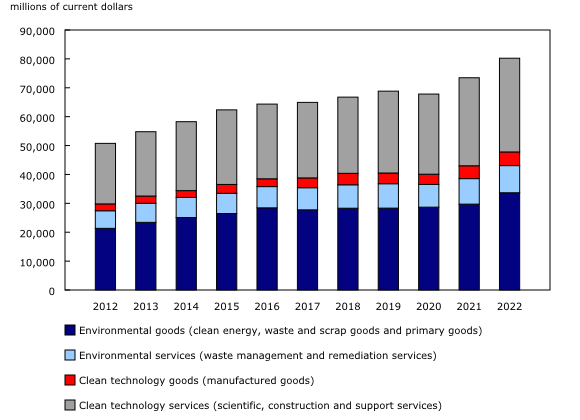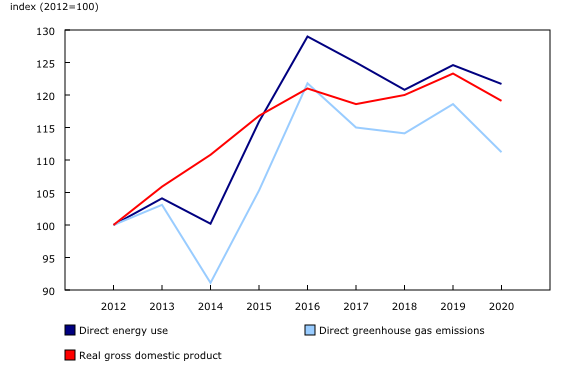Environmental and Clean Technology Products Economic Account, 2022
Released: 2024-01-10
The real gross domestic product (GDP) generated by the environmental and clean technology products sector increased for the second consecutive year, rising 1.2% in 2022 following a 1.9% gain in 2021. Nevertheless, the annual growth in the environment and clean technology sector in 2022 remained below pre-COVID-19 pandemic levels and was much slower than the overall economy growth (+3.9%).
The Environmental and Clean Technology Products Economic Account measures the production of goods and services that reduce environmental impacts' contribution to the Canadian economy. Two broad categories of goods and services are recognized: environmental goods and services, and clean technology goods and services.
In 2022, just over half (53.7%) of the national environmental and clean technology products sector's GDP was attributable to the production of environmental goods and services, specifically clean electricity (38.9%). The remaining 46.3% was attributable to the production of clean technology goods and services.
For a comprehensive overview of the annual changes in the environmental and clean technology products sector, refer to the data visualization tools entitled "Gross Domestic Product and trade in Canada's environmental and clean technology products sector" and "Employment and compensation of employees in Canada's environmental and clean technology products sector."
Ontario and Quebec account for almost two-thirds of the environmental and clean technology products sector gross domestic product
Ontario (34.3%) accounted for over one-third of the national economic activity in the environmental and clean technology products sector in 2022, while Quebec (30.0%) accounted for almost one-third and British Columbia (14.7%) one-seventh.
In Ontario, almost half (49.5%) of the environmental and clean technology sector's GDP was attributable to the clean technology services in 2022, while in Quebec, it was driven by the clean electricity (56.1%).
Manufactured goods account for largest share of environmental and clean technology products exports and imports
The volume of environmental and clean technology product exports decreased by 2.3% in 2022. Manufactured goods (37.9%) accounted for more than one-third of all exports, followed by the waste and scrap goods for recycling (24.0%) and clean electricity (21.1%).
The volume of environmental and clean technology product imports increased by 7.9% in 2022, with manufactured goods accounting for almost two-thirds (62.5%) of all imports.
Job growth in the environmental and clean technology products sector lags job growth in the economy overall, but wage growth is growing at a faster pace
An estimated 327,506 jobs were attributable to the environmental and clean technology products sector in 2022, up 1.3% from 2021, accounting for 1.6% of all jobs in Canada in 2022. By comparison, total jobs in Canada increased 4.6% over the same period.
The national average annual compensation per environmental and clean technology job, including benefits, increased 5.3% from 2021 to $101,595 in 2022, compared with an economy-wide average of $72,633 (up 4.5% from 2021).
Energy use and greenhouse gas emissions decrease in 2020 in the wake of the pandemic
The 3.4% decrease in national GDP in the environmental and clean technology products sector in 2020 coincided with both a 2.4% decrease in direct energy use and a 6.2% decrease in greenhouse gas (GHG) directly emitted during production. These trends aligned with the 4.9% decrease in overall Canadian GDP due to the pandemic.
In 2020, large decreases in energy use (-12.4%) and GHG emissions (-13.8%) in the clean technology products subsector, led by construction services, were moderated by increased energy use (+4.5%) and GHG emissions (+3.4%) in the environmental products subsector, led by biofuels and primary goods. The production of these goods had a greater impact overall on energy and GHG trends rather than on the GDP trends due to their increased energy use and GHG emission intensities.
Did you know we have a mobile app?
Get timely access to data right at your fingertips by downloading the StatsCAN app, available for free on the App Store and on Google Play.
Note to readers
The Environmental and Clean Technology Products Economic Account (ECTPEA) measures the economic contribution of environmental and clean technology products in terms of output, value added—defined as gross domestic product (GDP)—, employment (number of jobs) and other economic variables. Estimates are directly comparable with national results for the Canadian economy. Estimates of GDP referred to in this release are measured at basic prices.
Estimates for 2021 and 2022 are preliminary and will be revised when updated data become available, including the supply and use tables for those reference years.
Environmental and clean technology products are defined as any process, product or service that reduces environmental impacts through any of the following three strategies: environmental protection activities that prevent, reduce or eliminate pollution or any other degradation of the environment; resource management activities that result in the more efficient use of natural resources, thus safeguarding against their depletion; and the use of goods that have been adapted to be significantly less energy or resource intensive than the industry standard.
Two broad categories of environmental and clean technology products are recognized: environmental goods and services (including clean electricity, biofuels and primary goods, and waste management and remediation services) and clean technology goods and services (including manufactured goods, scientific and research and development services, construction services and support services). The products follow the Supply and Use Product Classification used in the Canadian System of Macroeconomic Accounts.
As part of the Government of Canada's initiative to develop the Clean Technology Data Strategy, the ECTPEA provides comprehensive measures of the supply and use of environmental and clean technology products in the Canadian economy. The ECTPEA has a broader scope than the Survey of Environmental Goods and Services because it captures all economy-wide transactions in the environmental and clean technology products sector, including elements such as clean energy and scrap goods. The government and non-profit sectors are also fully covered in the ECTPEA.
The compilation of the ECTPEA draws on a variety of data sources, including Statistics Canada's supply and use tables, detailed import and export statistics released in Canada's balance of international payments and the Survey of Environmental Goods and Services. The data on the energy use and GHG emissions result from the linkage of the ECTPEA with Statistics Canada's Physical Flow Account on energy use and GHG emissions, which is undertaken in collaboration with the Canadian Centre for Energy Information.
Examples of environmental goods and services and clean technologies are available in the publication Clean technologies and the Survey of Environmental Goods and Services: A technical reference guide (16-511-X).
Contact information
For more information, or to enquire about the concepts, methods or data quality of this release, contact us (toll-free 1-800-263-1136; 514-283-8300; infostats@statcan.gc.ca) or Media Relations (statcan.mediahotline-ligneinfomedias.statcan@statcan.gc.ca).
- Date modified:


